How to Plan Your Trip to Abu Simbel Temple
Planning a trip to Abu Simbel Temple in Egypt? Look no further for a comprehensive guide on how to make the most of your visit. From the best time to go to the logistical details of getting there, we've got you covered. Discover the fascinating history of the temple and learn about the impressive engineering feat that relocated it to its current location.
Get ready to be awestruck by the magnificent statues, elaborate carvings, and stunning architecture. Whether you're a history buff, an art enthusiast, or an adventurous traveler, Abu Simbel Temple is a must-see destination that will leave you in awe.
Overview of Abu Simbel Temple
Abu Simbel Temple is a UNESCO World Heritage site in southern Egypt, near the border with Sudan. It consists of two massive rock temples built during Pharaoh Ramses II's reign in the 13th century BC. The temples, dedicated to the gods Ra-Horakhty, Ptah, and Amun, were constructed to commemorate Ramses II's victory at the Battle of Kadesh and to showcase his power and divine right to rule.
The Great Temple, also known as the Temple of Ramses II, is the larger and more famous of the two. It features four colossal statues of Ramses II on its facade, each standing at a height of over 20 meters. The temple's interior is adorned with intricate carvings and hieroglyphics depicting scenes from Ramses II's military campaigns and religious rituals.
The Small Temple, dedicated to Ramses II's wife, Queen Nefertari, is equally impressive. It displays six statues at its entrance, four depicting Ramses II and two portraying Queen Nefertari. The temple's inner walls are decorated with colourful reliefs depicting Ramses II and Queen Nefertari in various divine and ceremonial roles.
Both temples were relocated in the 1960s to save them from being submerged under Lake Nasser during the construction of the Aswan High Dam. This extensive relocation effort was undertaken by UNESCO and the Egyptian government and involved cutting the temples into large blocks and reassembling them on higher ground.
Today, Abu Simbel Temple attracts visitors from around the world who marvel at its architectural grandeur, historical significance, and stunning artistic details. It is a must-visit destination on any trip to Egypt and offers a unique glimpse into ancient Egyptian civilization.

Significance and historical importance
The Abu Simbel Temple is a UNESCO World Heritage site in southern Egypt and holds significant historical importance. Built during the reign of Pharaoh Ramses II, the temple complex was created as a symbol of the pharaoh's power and dedication to the gods.
The main Abu Simbel Temple is carved into a solid rock cliff and consists of four colossal statues of Ramses II seated on a throne. The temple's facade is adorned with intricate carvings and hieroglyphics that tell the stories of the pharaoh's victories and divine lineage. The temple's interior features a series of halls and chambers, with the most impressive being the hypostyle hall, supported by eight massive pillars.
The smaller temple, dedicated to Ramses II's beloved wife, Queen Nefertari, is equally stunning. It features six statues of the pharaoh and the queen, expertly carved to depict their majesty and beauty.
Abu Simbel Temple's significance lies in its architectural beauty and the remarkable engineering feat of its relocation in the 1960s. With the construction of the Aswan High Dam and the resulting flooding of Lake Nasser, the temple complex was at risk of being submerged. In an international effort, the entire complex was painstakingly dismantled and relocated to higher ground, ensuring its preservation for future generations.
Visiting Abu Simbel is an awe-inspiring experience, allowing visitors to marvel at the grandeur of ancient Egyptian architecture and gain insight into the power and grandiose nature of the pharaohs.
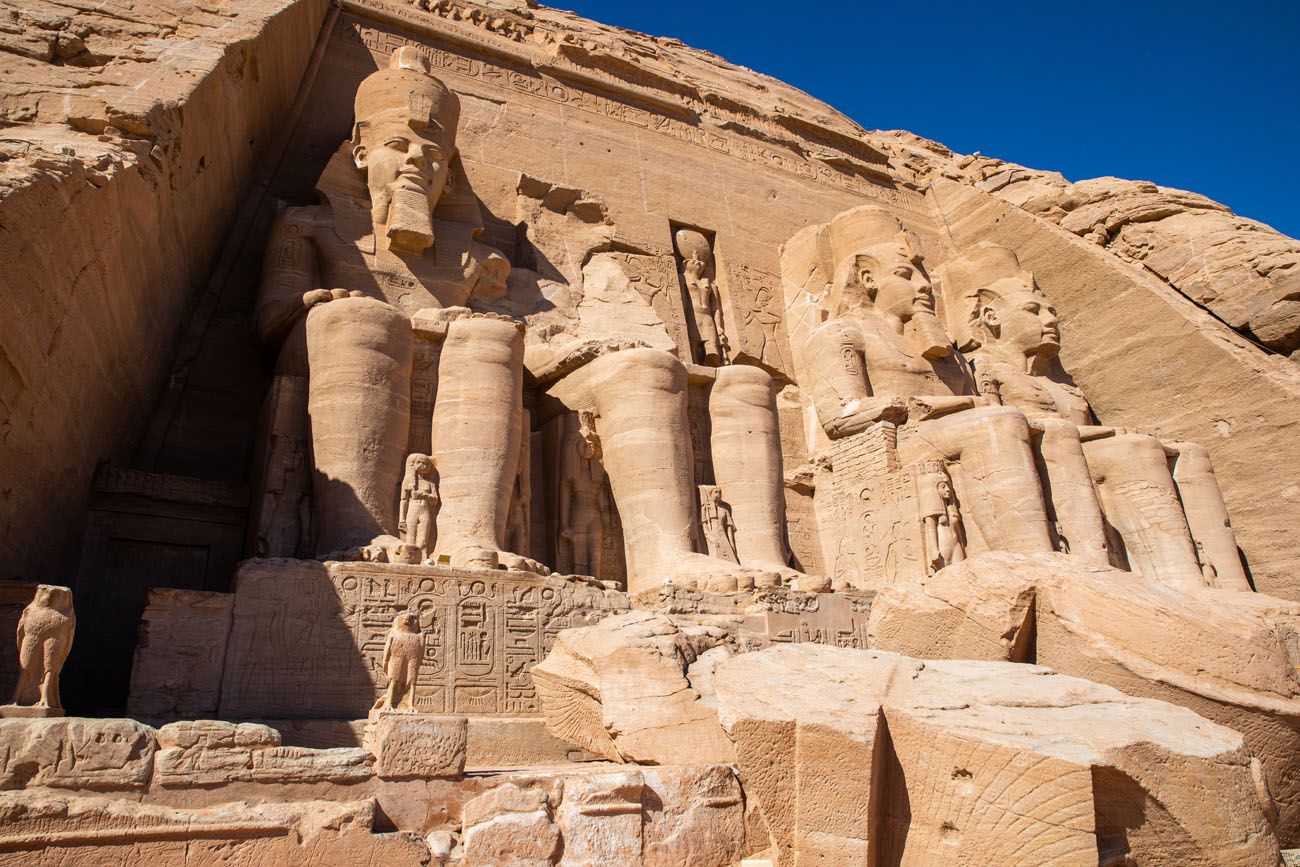
How to Get to Abu Simbel
Driving from Aswan/Luxor
If you're planning a trip to Abu Simbel Temple and prefer to drive from Aswan or Luxor, here's what you need to know:
-
Distance: The distance between Aswan and Abu Simbel is approximately 280 kilometres (175 miles), while Luxor and Abu Simbel are around 290 kilometres (180 miles).
-
Travel Time: The drive from Aswan to Abu Simbel takes 3-4 hours, depending on traffic and road conditions. From Luxor, the drive takes slightly longer, usually around 4-5 hours.
-
Route: The most common route to Abu Simbel from Aswan or Luxor is the Desert Highway. This well-maintained road offers scenic views of the desert landscape.
-
Transportation Options: You can rent a car and drive to Abu Simbel, hire a private driver, or join a guided tour. It's important to note that driving in Egypt can be challenging for those unfamiliar with local traffic and road etiquette.
-
Safety: While the road to Abu Simbel is generally considered safe, it's recommended to travel during daylight hours and follow any advice or warnings from local authorities.
-
Stops and Checkpoints: Along the route, there may be military or police checkpoints where your identification and permits will be checked. It's important to have all necessary documents readily available.
-
Comfort: The journey can be long, so bring snacks, water, and any necessary medication. There are also restrooms and cafeterias available along the way.
Remember to plan your trip accordingly and allow extra time in case of unexpected delays. If you're uncomfortable driving in Egypt or prefer a more hassle-free experience, flying to Abu Simbel is another viable option.
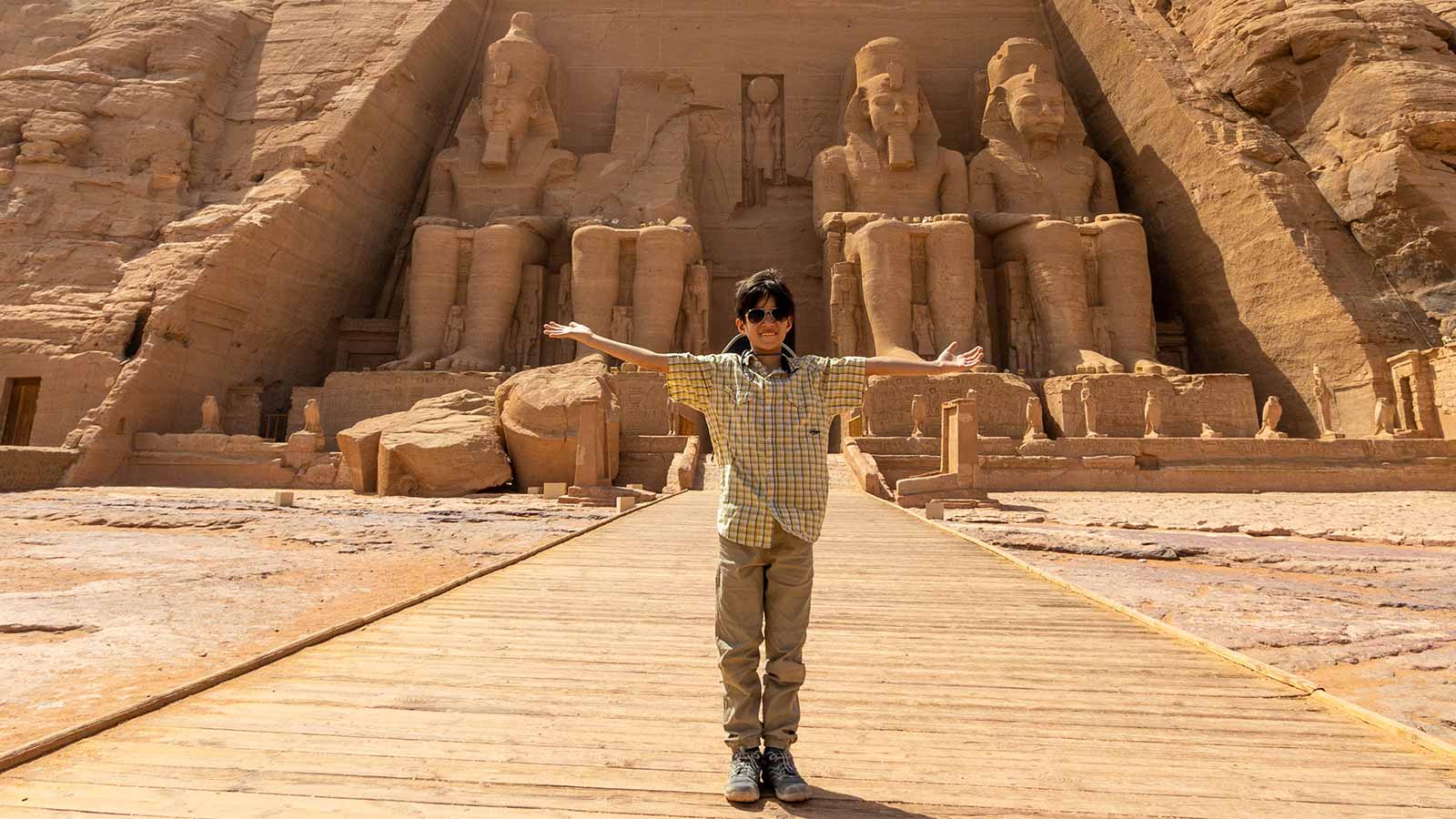
Flying to Abu Simbel
Flying is an excellent option if you prefer a faster and more convenient way to reach Abu Simbel Temple. The Abu Simbel Airport is located just a short distance from the temple complex, and regular flights are available from both Aswan and Luxor.
Here are some key points to consider when flying to Abu Simbel:
-
Convenience: Flying allows you to save time and energy compared to driving. The flight from Aswan is approximately 30 minutes, while it takes about 45 minutes from Luxor.
-
Aerial views: Enjoy stunning aerial views of the surrounding landscapes as you approach Abu Simbel. The flight provides a unique opportunity to see the temple complex differently.
-
Flight availability: Flights to Abu Simbel may be limited, and it is advisable to book in advance, especially during peak tourist seasons. Check with local airlines for flight schedules and availability.
-
Cost: Flying to Abu Simbel can be more expensive than driving, depending on your location and the time of year. However, the convenience and time saved may outweigh the additional cost for some travellers.
It's important to note that weather conditions and flight availability can sometimes affect schedules, so checking the latest information before your trip is recommended. Additionally, keep in mind that luggage restrictions may apply on domestic flights in Egypt, so be sure to check the regulations of the airline you choose.
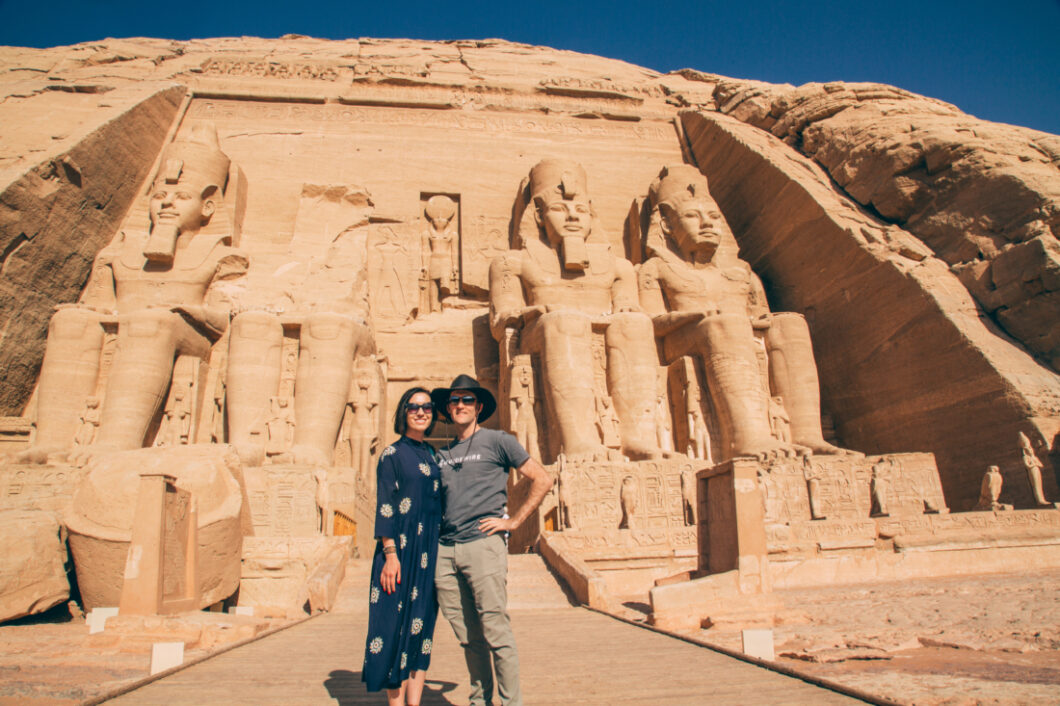
Safety Considerations
Is it safe to visit Abu Simbel?
Is it safe to visit Abu Simbel?
Abu Simbel, located in southern Egypt, is generally considered a safe place to visit. The Egyptian government and tourism authorities have taken significant measures to ensure the safety and security of tourists. There is a strong presence of security forces and checkpoints in the area.
However, it is always important to remain cautious and be aware of your surroundings when travelling to any location. Here are some tips to ensure a safe and enjoyable visit to Abu Simbel:
- Follow the advice and instructions of local authorities and tour guides.
- Stay informed about the current political and social situation in Egypt.
- Stick to authorized travel routes and avoid venturing into unknown or restricted areas.
- Keep your belongings secure and be vigilant against pickpocketing.
- Respect local customs and traditions.
- Dress modestly, especially when visiting religious sites.
- Purchase travel insurance that covers any unforeseen incidents or emergencies.
By taking these precautions and being mindful of your surroundings, you can have a safe and memorable visit to Abu Simbel.

Tips for a safe and enjoyable visit
When planning a visit to Abu Simbel Temple, it's important to keep in mind some tips to ensure a safe and enjoyable experience:
-
Dress appropriately: It is important to dress modestly out of respect for a religious site. Both men and women should cover their shoulders and knees. Sun protection, comfortable shoes, and a hat are also recommended due to the hot desert climate.
-
Bring plenty of water: Staying hydrated is crucial, especially in the desert heat. Carry a reusable water bottle and refill it throughout the day.
-
Arrive early: To avoid crowds and the hottest part of the day, arriving early in the morning when the temple opens is advisable. This allows for a more peaceful and enjoyable visit.
-
Follow photography guidelines: While photography is allowed in most areas, flash photography and tripods are generally prohibited. It's important to respect the rules and be mindful of other visitors.
-
Take breaks: The site is extensive, so it's important to pace yourself and take breaks when needed. There are shaded areas and benches available for resting.
-
Consider hiring a guide: Hiring a guide can enhance your visit by providing historical and cultural context. They can also help navigate the site and provide interesting insights.
-
Explore the surrounding area: Abu Simbel is located near Lake Nasser, so consider adding a boat trip or visiting nearby sites like the Nubian Village or the Temple of Hathor.
By following these tips, visitors can have a safe and enjoyable experience exploring the magnificent Abu Simbel Temple.
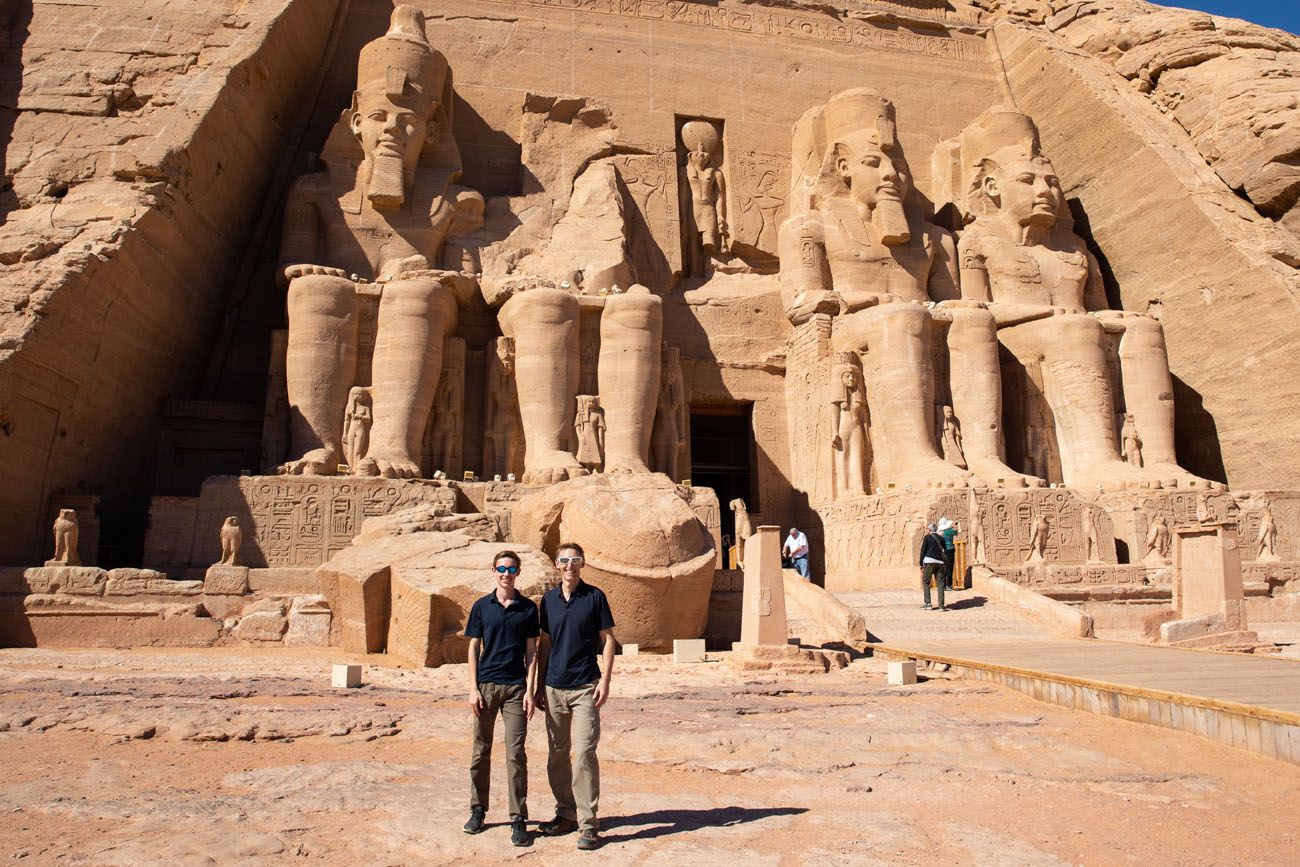
Guided vs Self-Guided Tour
Pros and cons of hiring a guide
When planning a trip to Abu Simbel Temple, hiring a guide can enhance the overall experience, but it also has its pros and cons:
Pros of hiring a guide:
- Expert knowledge: Guides are knowledgeable about the history, significance, and architecture of the temples, providing in-depth information and context.
- Insider tips: Guides can offer valuable insights and tips on the temples' best viewpoints, photo spots, and lesser-known aspects.
- Efficient navigation: Guides know the layout of the complex and can optimize the visit, ensuring you don't miss any highlights and maximizing your time.
- Language assistance: If you're not fluent in English or Arabic, having a guide who speaks your language can facilitate communication and understanding.
Cons of hiring a guide:
- Cost: Hiring a guide can add to the overall expenses of your trip, particularly if you're on a tight budget.
- Limited flexibility: Following a guide's itinerary may restrict your flexibility to explore at your own pace or spend more time in certain areas.
- Personal preferences: If you prefer a more immersive and self-guided experience, a guide may not align with your travel style.
- Availability and quality: Guides can vary in terms of knowledge, language proficiency, and professionalism, so it's essential to choose a reputable guide or agency.
Ultimately, the decision to hire a guide depends on your personal preferences, budget, and desired level of engagement. Whether you explore Abu Simbel independently or with a guide, the temple complex is a remarkable UNESCO World Heritage site that shouldn't be missed.
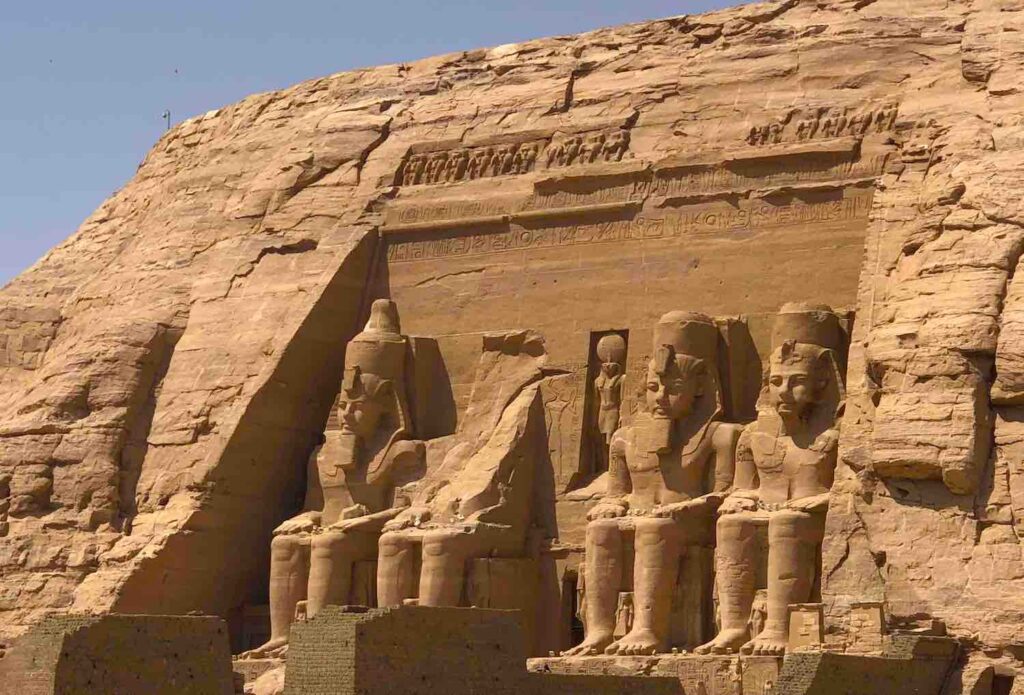
Exploring Abu Simbel on your own
Exploring Abu Simbel on your own can be a rewarding and immersive experience. Here are some tips to make the most of your visit:
-
Research: Before your trip, educate yourself about the history and significance of the Abu Simbel Temple. This will enhance your understanding and appreciation of the site.
-
Audio Guide: Consider renting an audio guide or downloading a mobile app that provides audio commentary. This will provide you with detailed information about the temples and their inscriptions.
-
Sunrise or Sunset: Plan your visit during sunrise or sunset when the temples are bathed in stunning golden light. This is the best time for photography and a truly magical experience.
-
Exploration: Take your time and explore both the Great Temple and the Small Temple. Marvel at the intricate carvings, admire the colossal statues and soak in the grandeur of the architecture.
-
Interact with the Locals: Engage with the friendly locals who can offer insights and stories about the temples and their history.
-
Respect the Rules: Follow the guidelines provided by the authorities, such as not touching or climbing on the ancient structures and respecting any restricted areas.
Exploring Abu Simbel on your own allows you to set your own pace and delve deeper into the history and beauty of this remarkable site.
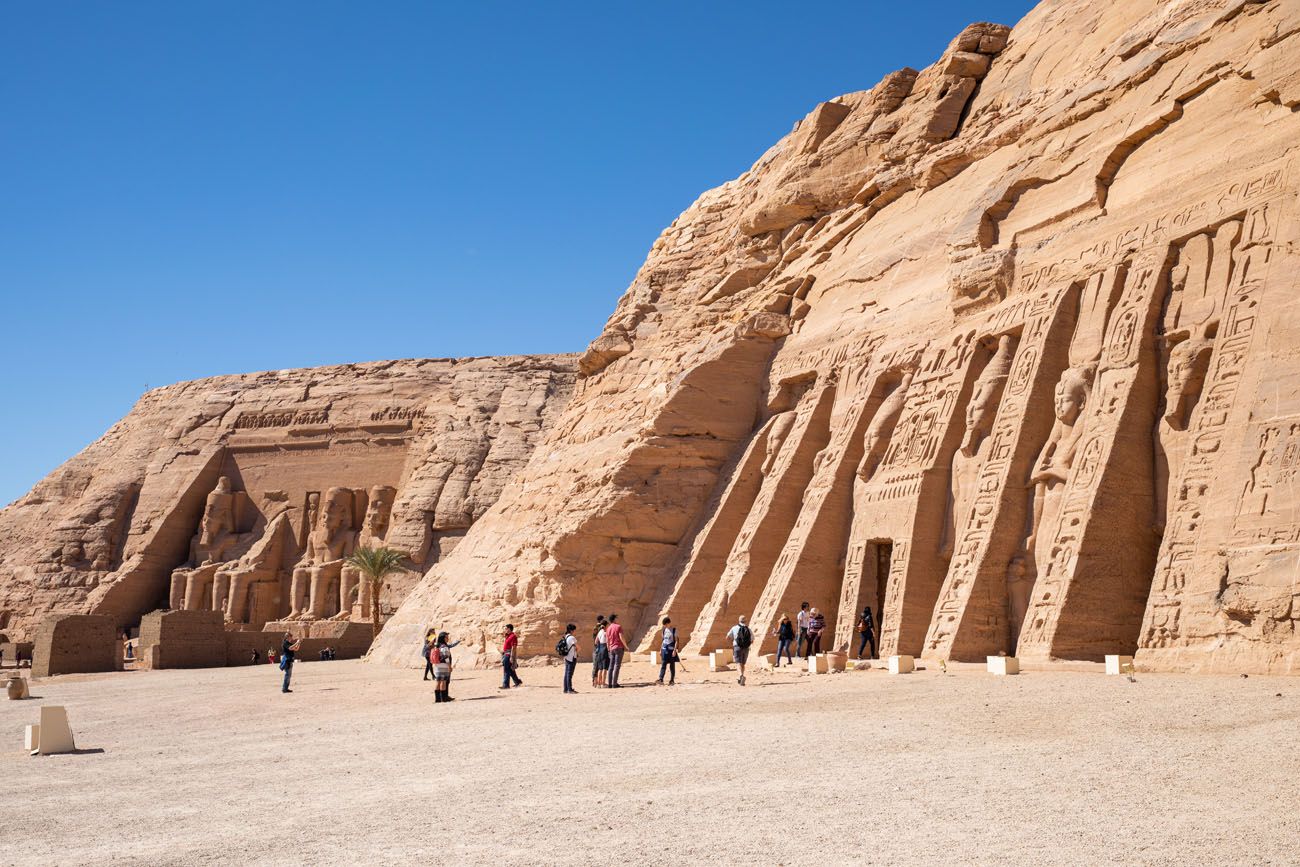
Abu Simbel Temple Complex
Description and Features of the Great Temple
The Great Temple of Abu Simbel is a marvel of ancient Egyptian architecture and a UNESCO World Heritage site. It was built by the pharaoh Ramses II around 1279 BCE and is a testament to his power and grandeur. The temple is dedicated to the gods Amun, Ra-Horakhty, Ptah, and the deified Ramses II himself.
Here are some key features and descriptions of the Great Temple:
-
Colossal Statues: The temple is flanked by four colossal statues of Ramses II, each standing around 20 meters tall. These statues depict the pharaoh seated, wearing the royal headdress and holding a crook and flail, symbols of his power and authority.
-
Facade: The temple's facade is adorned with intricate carvings and reliefs, depicting scenes of battle, victory, and religious rituals. These carvings showcase the pharaoh's military exploits and religious devotion.
-
Interior Halls: Upon entering the temple, visitors are greeted by a series of stunning halls and chambers. The hypostyle hall is most impressive, which features massive pillars adorned with intricate hieroglyphics and depictions of the pharaoh and the gods.
-
Inner Sanctum: At the heart of the temple lies the inner sanctuary, where four statue-like figures representing Amun, Ra-Horakhty, Ptah, and Ramses II, are bathed in sunlight twice a year during the solar alignment known as the "Sun Festival."
Visiting the Great Temple of Abu Simbel is a truly awe-inspiring experience and offers a glimpse into ancient Egypt's rich history and culture. Don't forget to bring your camera to capture the magnificence of this remarkable archaeological site.
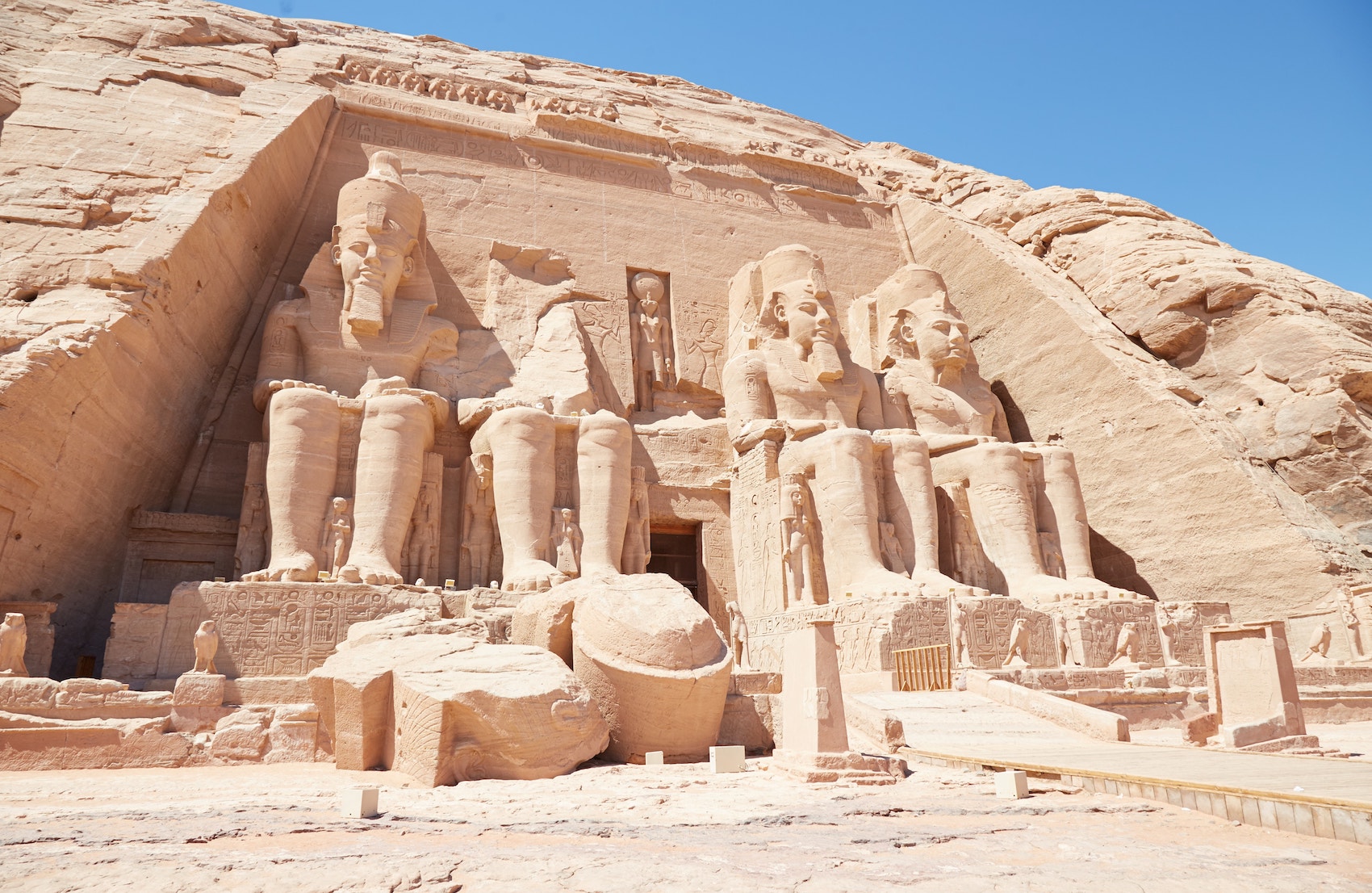
Description and Features of the Small Temple
The Small Temple of Abu Simbel is located north of the Great Temple and is dedicated to the goddess Hathor, the wife of Pharaoh Ramses II. This beautifully carved temple features a façade with six standing statues, four of Ramses II and two of his queen Nefertari. The entrance leads into a pillared hall with Hathor columns decorated with lotus and papyrus motifs. The temple walls are covered in colourful reliefs depicting scenes of Ramses II and Hathor and their divine union.
Inside the temple, there is a vestibule and three inner chambers. The vestibule features four square pillars adorned with representations of Ramses II and Hathor. The first chamber is the Birth Room, which depicts scenes of the pharaoh's divine birth. The second chamber is the Hypostyle Hall, which contains four Hathor columns and scenes of Ramses II in battle. The third chamber is the Shrine, where a seated statue of Hathor is housed.
Here are some key features of the Small Temple:
- The façade, with its statues of Ramses II and Nefertari, is a striking feature of the temple.
- The pillared hall with its beautifully decorated Hathor columns is a highlight.
- The reliefs on the walls depict scenes of Ramses II and Hathor, offering a glimpse into ancient Egyptian mythology and history.
- The Birth Room, Hypostyle Hall, and Shrine each have unique significance and stunning artwork.
Visitors to Abu Simbel will be fascinated by the intricate carvings and well-preserved artwork found in the Small Temple, which provides valuable insights into the beliefs and culture of ancient Egypt.
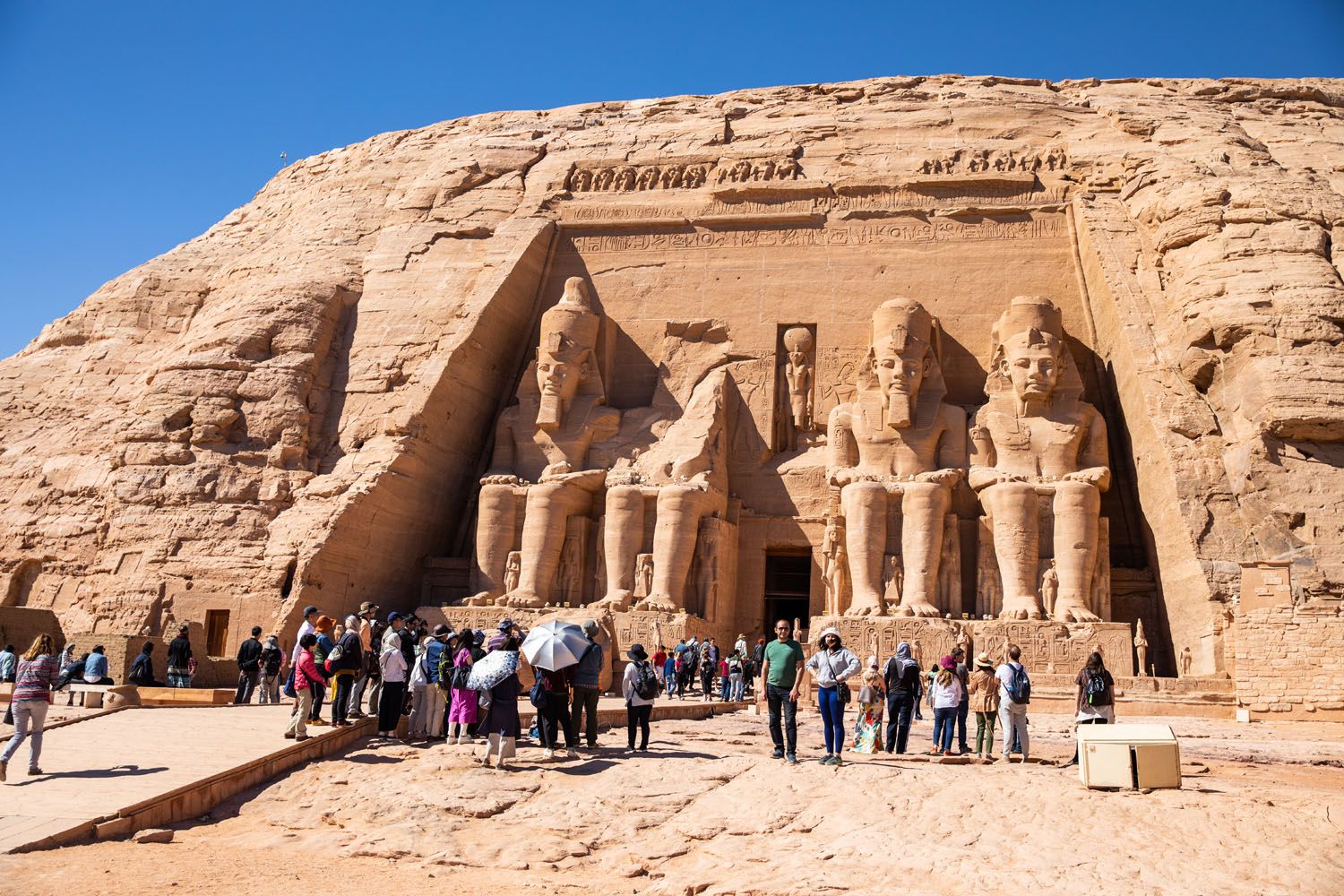
Visitor Tips and Recommendations
What to wear and bring
When planning your trip to Abu Simbel Temple, it's important to consider what to wear and bring to ensure a comfortable and enjoyable experience:
-
Clothing: Abu Simbel can get extremely hot, especially during the summer, so it's recommended to wear lightweight and breathable clothing. Opt for loose-fitting clothes that cover your shoulders and knees as a sign of respect for the sacred site. Sunscreen, sunglasses, and a hat are also essential to protect yourself from the sun.
-
Footwear: Comfortable walking shoes are necessary as you will explore the temple complex on foot. Choose closed-toe shoes that provide support and traction, as some areas may have uneven terrain.
-
Water and Snacks: It's important to stay hydrated, so bring plenty of water. Snacks such as energy bars or fruits are also recommended to keep your energy levels up during the visit.
-
Camera: Abu Simbel Temple is a remarkable site with stunning architectural details, so bringing a camera to capture the beauty is a must. However, checking the photography guidelines to ensure respectful snapping of pictures is important.
-
Cash: There are no ATMs or card payment facilities at Abu Simbel, so it's important to bring enough cash to cover entrance fees, souvenirs, and any other expenses you may have.
By being prepared and bringing the necessary items, you can enjoy your visit to the awe-inspiring Abu Simbel Temple.

Photography guidelines
When visiting Abu Simbel Temple, it's important to be aware of the photography guidelines to ensure a respectful and enjoyable visit:
- Photography is generally allowed inside both the Great Temple and the Small Temple. However, flash photography is strictly prohibited as it can damage delicate artwork and cause fading over time.
- Tripods and selfie sticks are also not allowed inside the temples, as they can obstruct the flow of visitors and create safety hazards.
- Using a camera with a good zoom lens or optical stabilizer is advisable to capture the intricate details of the temple walls and statues.
- Be cautious when taking photographs of the local people and seek their permission before capturing their images. Respect their privacy and cultural traditions.
- Remember to be mindful of the other tourists and avoid blocking their view or causing disturbances while taking photos.
- If you're unsure about any specific rules or guidelines regarding photography, it's always a good idea to ask the temple staff or your guide for clarification.
Following these guidelines will ensure you capture stunning images of this ancient wonder while respecting the heritage and preserving the site for future generations.

Nearby Attractions and Activities
Exploring the surrounding area of Abu Simbel
In addition to visiting the magnificent Abu Simbel Temples, visitors can explore several other attractions and activities in the surrounding area. Here are some highlights:
-
Lake Nasser: As the largest man-made lake in Africa, Lake Nasser offers stunning views and a serene environment. Many tourists enjoy boat trips to the lake to admire the landscape and wildlife.
-
Wadi El Seboua: This archaeological site is home to a collection of temples and ruins that were relocated during the construction of the High Dam. Visitors can explore the temples dedicated to Ramses II, enjoy the peaceful surroundings, and learn about the area's history.
-
Kalabsha Temple: Located about 35 kilometres north of Abu Simbel, Kalabsha Temple is another ancient site worth visiting. This well-preserved temple is dedicated to the Nubian god Mandulis and offers a glimpse into the region's rich history.
-
Camel Rides: For a unique and adventurous experience, visitors can take a camel ride through the desert surrounding Abu Simbel. This allows for a closer look at the natural landscape and provides great photo opportunities.
-
Nubian Villages: Visitors can take a trip to one of the Nubian villages near Abu Simbel to gain insights into the local culture and traditions. Here, you can interact with the friendly locals, learn about their way of life, and even enjoy traditional Nubian food.
Exploring the surrounding area of Abu Simbel offers a chance to delve deeper into the history and natural beauty of the region, making your trip even more memorable.

Excursions and day trips from Abu Simbel
If planning a trip to Abu Simbel, you may also consider taking excursions and day trips to explore the surrounding area. Here are some options to consider:
-
Lake Nasser Cruise: Take a cruise on Lake Nasser, the man-made lake created by the construction of the High Dam. This cruise will allow you to enjoy the stunning views of the lake and visit other ancient temples along its shores, such as the Temples of Amada, Wadi El Seboua, and Kalabsha.
-
Kom Ombo and Edfu Temples: These two temples are located along the Nile River between Aswan and Luxor. A day trip from Abu Simbel to visit these temples will allow you to explore more ancient Egyptian history and architecture. The Temple of Kom Ombo is dedicated to two gods, Sobek and Horus, while the Temple of Edfu is dedicated to the falcon-headed god, Horus.
-
Aswan High Dam: If you haven't visited the Aswan High Dam yet, a day trip from Abu Simbel is worth considering. This modern marvel of engineering played a crucial role in controlling the flooding of the Nile River and was instrumental in the construction of Lake Nasser.
-
Philae Temple: Located on an island near Aswan, the Philae Temple is dedicated to the goddess Isis. This temple was also relocated to its current location due to the construction of the High Dam. Taking a day trip to see this temple will give you a deeper appreciation of the complexities of ancient Egyptian architecture and religious beliefs.
When planning these excursions and day trips, it's essential to consider travel time and logistics. Depending on your preferences and budget, you may need to arrange transportation, either by booking a tour or hiring a private car. Additionally, check each destination's opening hours and ticket prices to optimize your time and experience.
